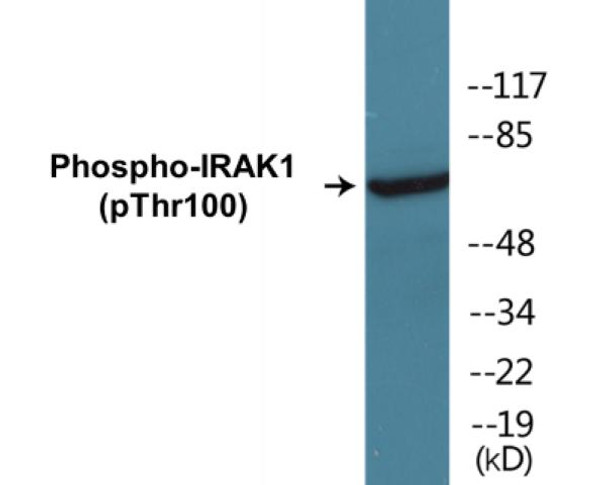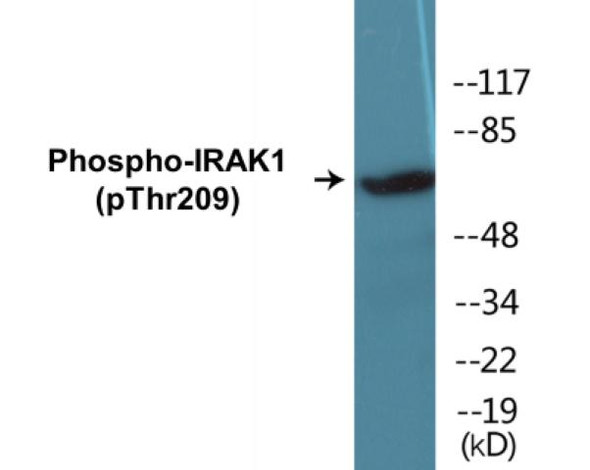Description
IRAK1 (Phospho-Thr100) Cell-Based ELISA Kit
The IRAK1 (Phospho-Thr100) Cell-Based ELISA Kit is a convenient, lysate- free, high throughput and sensitive assay kit that can monitor IRAK1 phosphorylation and expression profile in cells. The kit can be used for measuring the relative amounts of phosphorylated IRAK1 in cultured cells as well as screening for the effects that various treatments, inhibitors (ie. siRNA or chemicals), or activators have on IRAK1 phosphorylation.
How does our IRAK1 (Phospho-Thr100) Fluorometric Cell-Based ELISA Kit work?
Qualitative determination of IRAK1 (Phospho-Thr100) concentration is achieved by an indirect ELISA format. In essence, IRAK1 (Phospho-Thr100) is captured by IRAK1 (Phospho-Thr100)-specific primary (1°) antibodies while Dye 1-conjugated and Dye 2-conjugated secondary (2°) antibodies bind the Fc region of the 1° antibody. Through this binding, the dye conjugated to the 2° antibody can emit light at a certain wavelength given proper excitation, hence allowing for a fluorometric detection method. Due to the qualitative nature of the Cell-Based ELISA, multiple normalization methods are needed:
| 1. | A monoclonal antibody specific for human GAPDH is included to serve as an internal positive control in normalizing the target RFU values. |
| 2. | An antibody against the nonphosphorylated counterpart of IRAK1 (Phospho-Thr100) is also provided for normalization purposes. The RFU values obtained for non-phosphorylated IRAK1 can be used to normalize the RFU value for phosphorylated IRAK1. |
IRAK1 (Phospho-Thr100) Fluorometric Cell-Based ELISA Kit -Information
| Product Name: | IRAK1 (Phospho-Thr100) Fluorometric Cell-Based ELISA Kit |
| Product Code/SKU: | FBCAB00052 |
| Description: | The IRAK1 (Phospho-Thr100) Fluorometric Cell-Based Phospho ELISA Kit is a convenient, lysate-free, high throughput and sensitive assay kit that can monitor IRAK1 (Phospho-Thr100) protein phosphorylation and expression profile in cells. The kit can be used for measuring the relative amounts of phosphorylated IRAK1 (Phospho-Thr100) in cultured cells as well as screening for the effects that various treatments, inhibitors (ie. siRNA or chemicals, or activators have on IRAK1 phosphorylation. |
| Dynamic Range: | > 5000 Cells |
| Detection Method: | Fluorometric |
| Storage/Stability: | 4°C/6 Months |
| Reactivity: | Human, Mouse, Rat |
| Assay Type: | Cell-Based ELISA |
| Database Links: | Gene ID: 3654, UniProt ID: P51617, OMIM #: 300283, Unigene #: Hs.200716/Hs.522819 |
| Format: | Two 96-Well Plates |
| NCBI Gene Symbol: | IRAK1 |
| Sub Type: | Phospho |
| Target Name: | Phospho-IRAK1 (Thr100) |
Kit Principle
Figure: Schematic representation of Assay Genie Cell-Based Fluorometric ELISA principle
Kit components | Quantity |
| 96-Well Black Cell CultureClear-Bottom Microplate | 2 plates |
| 10X TBS | 24 ml |
| Quenching Buffer | 24 ml |
| Blocking Buffer | 50 ml |
| 15X Wash Buffer | 50 ml |
| Primary Antibody Diluent | 12 ml |
| 100x Anti-Phospho Target Antibody | 60 µl |
| 100x Anti-Target Antibody | 60 µl |
| Anti-GAPDH Antibody | 110 µl |
| Dye-1 Conjugated Anti-Rabbit IgG Antibody | 6 ml |
| Dye-2 Conjugated Anti-Mouse IgG Antibody | 6 ml |
| Adhesive Plate Seals | 2 seals |
Additional equipment and materials required
The following materials and/or equipment are NOT provided in this kit but are necessary to successfully conduct the experiment:
- Fluorescent plate reader with two channels at Ex/Em: 651/667 and 495/521
- Micropipettes capable of measuring volumes from 1 µl to 1 ml
- Deionized or sterile water (ddH2O)
- 37% formaldehyde (Sigma Cat# F-8775) or formaldehyde from other sources
- Squirt bottle, manifold dispenser, multichannel pipette reservoir or automated microplate washer
- Graph paper or computer software capable of generating or displaying logarithmic functions
- Absorbent papers or vacuum aspirator
- Test tubes or microfuge tubes capable of storing ≥1 ml
- Poly-L-Lysine (Sigma Cat# P4832 for suspension cells)
- Orbital shaker (optional)
Kit Protocol
This is a summarized version of the kit protocol. Please view the technical manual of this kit for information on sample preparation, reagent preparation and plate lay out.
| 1. | Seed 200 µl of desired cell concentration in culture medium into each well of the 96-well plates. For suspension cells and loosely attached cells, coat the plates with 100 µl of 10 µg/ml Poly-L-Lysine (not included) to each well of a 96-well plate for 30 minutes at 37°C prior to adding cells. |
| 2. | Incubate the cells for overnight at 37°C, 5% CO2. |
| 3. | Treat the cells as desired. |
| 4. | Remove the cell culture medium and rinse with 200 µl of 1x TBS, twice. |
| 5. | Fix the cells by incubating with 100 µl of Fixing Solution for 20 minutes at room temperature. The 4% formaldehyde is used for adherent cells and 8% formaldehyde is used for suspension cells and loosely attached cells. |
| 6. | Remove the Fixing Solution and wash the plate 3 times with 200 µl 1x Wash Buffer for 3 minutes. The plate can be stored at 4°C for a week. |
| 7. | Add 100 µl of Quenching Buffer and incubate for 20 minutes at room temperature. |
| 8. | Wash the plate 3 times with 1x Wash Buffer for 3 minutes each time. |
| 9. | Dispense 200 µl of Blocking Buffer and incubate for 1 hour at room temperature. |
| 10. | Wash 3 times with 200 µl of 1x Wash Buffer for 3 minutes each time. |
| 11. | Add 50 µl of Primary Antibody Mixture P to corresponding wells for IRAK1 (Phospho-Thr100) detection. Add 50 µl of Primary Antibody Mixture NP to the corresponding wells for total IRAK1 detection. Cover the plate with parafilm and incubate for 16 hours (overnight) at 4°C. If the target expression is known to be high, incubate for 2 hours at room temperature. |
| 12. | Wash 3 times with 200 µl of 1x Wash Buffer for 3 minutes each time. |
| 13. | Add 50 ul of Secondary Antibody Mixture to corresponding wells and incubate for 1.5 hours at room temperature in the dark. |
| 14. | Wash 3 times with 200 µl of 1x Wash Buffer for 3 minutes each time. |
| 15. | Read the plate(s) at Ex/Em: 651/667 (Dye 1) and 495/521 (Dye 2). Shield plates from direct light exposure. |
| 16. | Wash 3 times with 200 µl of 1x Wash Buffer for 5 minutes each time. |
IRAK1 (Phospho-Thr100) - Protein Information
| UniProt Protein Function: | IRAK1: a TKL kinase of the IRAK family. Involved in Toll/IL-1 signaling. One of two putative serine/threonine kinases that become associated with the interleukin-1 receptor following IL-1 engagement, triggering intracellular signaling cascades leading to transcriptional up-regulation and mRNA stabilization. Extensively phosphorylated after its association with IL1-R-1. Polyubiquitinated; after cell stimulation with IL-1-beta. Polyubiquitination occurs with polyubiquitin chains linked through 'Lys-63'. Partially responsible for IL1-induced upregulation of the transcription factor NF-kappa B. Three isoforms of the human protein and produced by alternative splicing. Isoform 1 binds rapidly but is then degraded allowing isoform 2 to mediate a slower, more sustained response to the cytokine. Isoform 2 is inactive suggesting that the kinase activity of this enzyme is not required for IL-1 signaling. Once phosphorylated, IRAK1 recruits the adapter protein PELI1. Isoform 1 and isoform 2 are ubiquitously expressed in all tissues examined, with isoform 1 being more strongly expressed than isoform 2. |
| UniProt Protein Details: | Protein type:Protein kinase, TKL; EC 2.7.11.1; Protein kinase, Ser/Thr (non-receptor); Kinase, protein; TKL group; IRAK family Chromosomal Location of Human Ortholog: Xq28 Cellular Component: cytoplasm; cytosol; endosome membrane; lipid particle; nucleus; plasma membrane Molecular Function:kinase activity; NF-kappaB-inducing kinase activity; protein binding; protein heterodimerization activity; protein homodimerization activity; protein kinase activity; protein serine/threonine kinase activity Biological Process: activation of MAPK activity; activation of NF-kappaB transcription factor; activation of NF-kappaB-inducing kinase; inhibition of NF-kappaB transcription factor; JNK cascade; lipopolysaccharide-mediated signaling pathway; MyD88-dependent toll-like receptor signaling pathway; negative regulation of apoptosis; positive regulation of I-kappaB kinase/NF-kappaB cascade; positive regulation of interferon type I production; positive regulation of MAP kinase activity; protein amino acid autophosphorylation; protein amino acid phosphorylation; protein oligomerization; regulation of cytokine and chemokine mediated signaling pathway; response to lipopolysaccharide; toll-like receptor 2 signaling pathway; toll-like receptor 4 signaling pathway; toll-like receptor 9 signaling pathway; toll-like receptor signaling pathway |
| NCBI Summary: | This gene encodes the interleukin-1 receptor-associated kinase 1, one of two putative serine/threonine kinases that become associated with the interleukin-1 receptor (IL1R) upon stimulation. This gene is partially responsible for IL1-induced upregulation of the transcription factor NF-kappa B. Alternatively spliced transcript variants encoding different isoforms have been found for this gene. [provided by RefSeq, Jul 2008] |
| UniProt Code: | P51617 |
| NCBI GenInfo Identifier: | 8928535 |
| NCBI Gene ID: | 3654 |
| NCBI Accession: | P51617.2 |
| UniProt Secondary Accession: | P51617,Q7Z5V4, Q96C06, Q96RL2, D3DWW3, D3DWW4, |
| UniProt Related Accession: | P51617 |
| Molecular Weight: | 68,022 Da |
| NCBI Full Name: | Interleukin-1 receptor-associated kinase 1 |
| NCBI Synonym Full Names: | interleukin 1 receptor associated kinase 1 |
| NCBI Official Symbol: | IRAK1 |
| NCBI Official Synonym Symbols: | IRAK; pelle |
| NCBI Protein Information: | interleukin-1 receptor-associated kinase 1 |
| UniProt Protein Name: | Interleukin-1 receptor-associated kinase 1 |
| Protein Family: | Interleukin-1 receptor-associated kinase |
| UniProt Gene Name: | IRAK1 |
| UniProt Entry Name: | IRAK1_HUMAN |







